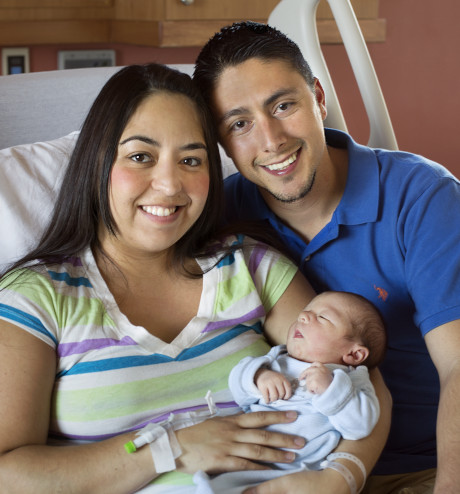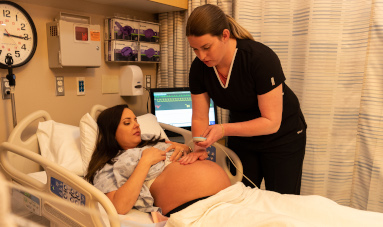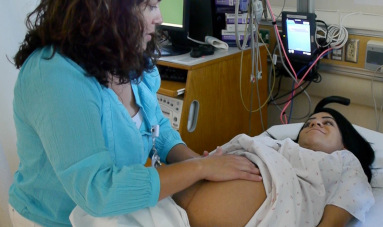
5 Tips for What to Include in Your Birth Plan

When you find out you’re pregnant, it can be fun to start picking out names and finding cute onesies, but one of the most important things you'll plan is how you envision your labor and birth experience.
For many moms, that means creating a birth plan with your OB/GYN or midwife. Birth plans help you explain your wishes and goals for your pregnancy and birth. They also help your provider show what may or may not be possible, along with all your options for pain management, doula support and including your partner in the birth.
Many moms like to start with a birth plan template, such as the one we provide at UNM Hospital. But remember: This is your plan, and it should be more than a simple checklist.
Let’s discuss a few things we recommend women include in their birth plans.
1. Flexible Options for the Unexpected
Every good birth plan is flexible. During labor and delivery, things can change quickly. For example, you might have a much quicker or longer delivery than expected, which can change your plans.
To be as prepared as possible, we recommend imagining multiple labor and birth scenarios and make more than one plan. Having alternate plans can help you feel more in control.
For example, if you are planning a vaginal birth but you need an emergency C-section, what might be important to you? What is your second and third option for pain control if deep breathing or sitting in the birth tub isn't enough?
If you’ve given birth in the past, you may want to change some things this time based on what you learned. Remember that no two labors and births are exactly the same. This time around might look very different.
2. Choose a Health Care Provider & Birth Location
You might not think of this as being part of your birth plan, but it’s an important decision for your experience.
There are unique benefits to the different types of provider who can help deliver your baby. You may want to talk to a few providers to find one who makes you feel comfortable. At UNM Hospital, you can choose a certified nurse-midwife, a family medicine doctor, or an OB/GYN to guide and support you through pregnancy and birth.
Also, think about where you want to give birth. UNM Hospital is the only Level 4 maternity care center in New Mexico. Here, we care for moms and newborns from all over the state, including low-risk and high-risk pregnancies. We support your pregnancy and birth choices, and we will individualize care to meet your needs and preferences.
Some hospitals, like UNM, are teaching centers for future doctors, midwives and nurses. Make a note in your birth plan about whether you are comfortable with students or residents being present during your labor and birth. Choosing one way or the other will not affect the quality of your care.
Make sure the birthplace you choose has the resources and services you want and need for labor and birth. If you or your baby have a health condition that makes your pregnancy higher risk, choose a hospital that can handle your unique needs.

3. Pick Your Support Person
Having a support person during labor can improve your experience. A 2017 Cochrane review found that women who had continuous support during labor and delivery were less likely to use pain medications or have C-sections. They also were more likely to have shorter births and be more satisfied overall with their birth experiences.
Along with your health care team, who will be your support person during labor? This may be your partner, mom or best friend. Many women choose to work with doulas—trained professionals who provide emotional and physical support during pregnancy, labor and birth. Due to COVID-19, there are limits on how many people can attend the birth or visit at the hospital.

Related Reading
Who Should be in the Delivery Room? How to Choose the Best Labor Support Person
4. Explore Pain Management Options
Labor and birth can be painful. But there are many options to manage the pain, from breathing techniques and position changes you learned in childbirth classes to IV medication or an epidural block, which numbs the body from the waist down.
Some women find a warm shower or bath can help soothe the pain. All of our birthing rooms have showers, and many also have a tub. We have a private tub room for your use if your room does not have one.
UNM Hospital also offers nitrous oxide to ease labor discomfort. Also known as "laughing gas," you can breathe in this safe, odorless gas through a mask to curb contraction pain. During the pandemic, nitrous oxide is not available. However, we will bring it back when the pandemic subsides.
You could also try our transcutaneous electrical nerve stimulation (TENS) unit to block labor pain. This handheld machine delivers small pulses of electrical current to your body through your back. TENS doesn’t involve needles or drugs, and it feels like a tingling sensation on the skin.
Not every hospital has the same resources. Talk with your health care provider about the types of pain management options your birthplace offers. And don’t forget, once labor starts, you can always change your birth plan if you find what you thought you needed isn’t enough to ease the pain.
5. Decide How You Want to Feed Your Newborn
Let your health care team know in advance if you choose to breastfeed or formula feed your baby.
UNM Hospital is a designated Baby-Friendly hospital, which means we promote immediate breastfeeding and mother-baby bonding. Most of our patients choose to breastfeed their newborns. Whenever possible, we initiate skin-to-skin contact immediately after delivery and try to start breastfeeding within an hour of birth.
Whatever you choose, we will support your decision and help you feed the baby soon after delivery.

A Few Final Thoughts
Birth plans can be as long or short as you need them to be. I would like to mention just a couple more items to think about before you go into labor.
- Atmosphere: Do you want music to be playing or the room to be as quiet as possible? Do you want the lights dimmed? Note these preferences in your birth plan. If it's safe to do so, we will help make it happen.
- Personal belongings: You may feel more comfortable if you bring along items that are familiar to you. This could be a favorite pillow or blanket or framed photos to put beside the bed. Check with your health care provider to make sure items you want to bring are allowed.
- Delayed cord clamping: For many years, health care providers have clamped and cut the umbilical cord immediately after birth. Here, all providers offer delayed cord clamping. That means we wait from one to several minutes after delivery, allowing for more blood to transfer from the placenta to the baby. If you desire and it is safe, we can wait until the cord stops pulsing. Let your provider know if you are interested in this option.
- Contraception: It may seem odd to think about birth control before your baby is born, but there are some things we need to know in advance. For example, let us know if you want an intrauterine device (IUD) placed right after delivery or if you want your tubes tied—some insurance companies require 30 days' notice of that procedure.
Once you and your health care provider have agreed on a final birth plan, make several copies so they are available for the labor, delivery and postpartum care teams.
Creating a birth plan can help you prepare for the expected and unexpected events of bringing a baby into the world. Even if things have to change, we will do what we can to give you a positive birth experience. At the end of the day, the goal of every birth plan is the same: A healthy and happy baby and mom.
To visit with a midwife or OB/Gyn, call 505-272-2245.
